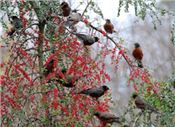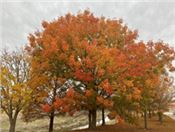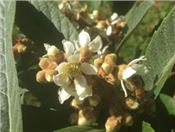|
The Best Time To Plant A Tree Is Now
BATON ROUGE, LA.
Many of us get a generous amount of time off for the holidays at the end of each year. This time is best spent with family, reflecting on the past year and looking forward to the next. It is also a great time to get outside and get things done in the garden.
We are very fortunate here in the South to have good weather during the winter months for gardening, and it is an excellent time to plant trees and shrubs in the landscape.
Although deciduous trees and shrubs are in their dormancy, roots are still actively growing. Planting during December, January and February provides plants with several months to develop a strong root system before they put out a new flush of leaves and flowers in spring.
The structure of trees and shrubs in our lawns and gardens is very apparent this time of year. Dead branches, low-hanging branches and branches that cross one another are visible now and should be removed. Take this opportunity to trim your trees and shrubs. Removal will be much easier without the additional weight of leaves.
As retail nurseries begin clearing out Christmas trees and merchandise, they will be bringing in a new stock of woody trees and shrubs. Tropical plants will be available later in the warmer season when they are less likely damage by colder temperature.
The National Arbor Day Foundation has started the Time for Trees initiative to highlight how “trees clean our air, protect our drinking water, create healthy communities and feed the human soul.” Founded by J. Sterling Morton in 1872 in Nebraska City, Nebraska, where an estimated 1 million trees were planted, Arbor Day is celebrated every year. In 2021 it will be celebrated in most of the country on April 30. On this day, individuals are encouraged to plant trees.
Louisiana celebrates Arbor Day on the third Friday of January. The LSU AgCenter Botanic Gardens will hold its annual Arbor Day event on Jan. 23 from 9 a.m. to 1 p.m. Free and open to the public, this event will feature educational talks on native trees given by experts from the LSU AgCenter. You and your family can plant a tree while there and get GPS coordinates so you can come back and visit “your” tree and watch it grow for generations to come.
When deciding what trees and shrubs to purchase and plant, it is best to sit down and consider the year-round interest of those plants. A great design will beauty and interest in each season. That can include evergreen plants, flowering plants and deciduous plants that have excellent fall foliage change.
Evergreen trees and shrubs provide year-round greenery and are popular in almost every landscape design. Some good, large evergreen trees include live oak (Quercus virginiana), Southern magnolia (Magnolia grandiflora), Leyland cypress (Cupressus × leylandii) and American holly (Ilex opaca).
Southern magnolia has fragrant white flowers in late spring to mid-summer, and the female trees of American holly sport gorgeous red berries in winter that attract birds and other wildlife.
Some medium-sized evergreen trees are Southern wax myrtle (Morella cerifera), camphor tree (Cinnamomum camphora) and red bay (Persea borbonia).
You can choose from several small evergreen trees with many different functions. Some have flowers and put on a display in the late fall into early spring. These include camellia (Camellia japonica) and camellia sasanqua (Camellia sasanqua).
Other fragrant flowering trees include loquat (Eriobotyra japonica), banana shrub (Michelia figo) and sweet olive (Osmanthus fragrans). Other trees – including Burford Chinese holly (Ilex cornuta ‘Burfordii’), yaupon holly (Ilex vomitoria) and eastern red cedar (Juniperus virginiana) – provide ecosystem services such as wildlife food.
Compared to evergreen trees, deciduous tree have a much larger selection for use Louisiana. Some large deciduous trees with good fall foliage change that are great as shade trees for the landscape are American beech (Fagus gramdifolia), bald cypress (Taxodium distichum), basswood pecan (Carya illionensis), tulip tree (Liriodendron tulipifera), sycamore (Platanus occidentalis) and cucumber magnolia (Magnolia acuminate).
Some outstanding small, spring-flowering deciduous trees are fringe tree (Chionanthus virginicus), flowering dogwood (Cornus florida), Taiwan cherry (Prunus campanulata), saucer magnolia (Magnolia X soulangiana), parsley hawthorn (Crataegus marshallii), redbud (Cercis Canadensis) and silverbell (Halesia diptera).
Other deciduous trees with outstanding fall foliage change are hornbeam (Carpinus caroliana), swamp red maple (Acer rubrum ‘Drummondii’), Japanese maple (acer palmatum), southern sugar maple (Acer barbatum), green ash (Fraxinus pennsylvanica), sweetgum (Liquidambar styraciflua), Chinese pistache (Pistacia chinensis) and many oak species such as shumard oak (Quercus shumardii), nuttall oak (Quercus nuttallii), white oak (Quercus alba) and post oak (Quercus stellata).
Planting trees is a great way to leave a lasting legacy for generations to come to enjoy. In my humble opinion, trees are the key to combating climate change by conserving energy, sequestering carbon and reducing the overall concentration of greenhouse gases in the atmosphere.
Consider this Chinese proverb: “The best time to plant a tree was 20 years ago. The second-best time is now.” ∆

American robin on native holly.
Photo by Norman Winter

Chinese pistache is an excellent medium-sized deciduous tree for fall foliage.
Photo by Heather Kirk-Ballard/LSU AgCenter

Loquats are great evergreen tree with sweetly scented flowers in late autumn.
Photo by Heather Kirk-Ballard/LSU AgCenter
|
|